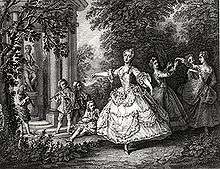Marie Sallé
.jpg)
Marie Sallé (1707–1756) was a French dancer and choreographer known for her expressive, dramatic performances rather than a series of "leaps and frolics" typical of ballet of her time.[1]
Biography
Sallé was the first notable female choreographer and the first woman to choreograph a ballet in which she also danced. As a choreographer she integrated music, costumes, and dance styles of her ballets with their themes, thereby anticipating the reforms made by choreographer Jean-Georges Noverre in the late 18th century.[1] She argued that costumes should reflect and represent the character, a novel idea at the time. This engendered a sense of "realism" that had been largely ignored up to this point in the evolution of ballet and also allowed for greater physical freedom among the female dancers, especially, allowing them more opportunities without the restrictions of unwieldy and elaborate clothing on stage. She changed the costume from heavy long dress to muslin flowing material which caused shock and delight. She often performed without a skirt or bodice(sans-panniers), rebelling against the traditional costume and accepted gender norms of a very regimented era.[1] She also worked in collaboration with composers such as George Handel and Christoph Gluck, commissioning compositions from them for her choreography, which helped to garner more respect for ballet as its own distinct art form.
The daughter of a tumbler, Sallé studied with ballerina Françoise Prévost,[2] who sponsored her debut in 1721 at the Paris Opéra. It is also thought possible that she studied with Claude Balon, who worked at the Paris Opéra.[3] Sallé and dancer Marie Camargo were Prévost's two most prominent students. Although the two dancers studied together, they formed very different approaches to their dancing.[3] Camargo became the technician, while Sallé became the actress. Prévost taught both Camargo and Sallé her Les Caractères de la Danse, but Sallé turned it into a pas de deux for herself and a male, enabling the display of emotions between the two of them. Sallé made her debut in 1718 at St. Laurent’s Fair in “La Princesse Charisme”, created by Véronique Lesage. She moved from Paris to London in 1725 with the help of John Rich, finding greater success. Her initial performances there took place at Lincoln's Inn Fields Theatre at London, where she performed dances from George Frideric Handel's opera Rinaldo as well as pantomimes with her brother.[3] In 1734 she was engaged by John Rich to perform at Covent Garden: she danced in Terpsicore, a prologue to a revision of Handel's Il pastor fido, and in the premieres of the same composer's Alcina and Ariodante. In 1734 she also choreographed and performed in Pygmalion,[1] her most famous work, a mythological tale of a statue that comes to life and the sculptor who creates it. In "Pygmalion", Sallé chose to dress in Greek robes, wear her hair down and dance in sandals while playing the role of the statue in an attempt to make it a more realistic characterization. According to Susan Au, her choreography "gave the impression of a danced conversation" (Ballet and Modern Dance 32). This work enabled Sallé to rise to fame, and she traveled to Paris to dance for the King and Queen. Sallé eventually retired from performing in 1740.[3] Sallé came out of retirement for a few performances at Versailles between 1745-47 before her death on June 27, 1756.


See also
References
- 1 2 3 4 Garfunkel, written by Trudy (1994). On wings of joy : the story of ballet from the 16th century to today (1st ed.). Boston: Little, Brown and Co. pp. 19–22. ISBN 9780316304122.
- ↑ Mackrell, [edited by] Debra Craine, Judith (2000). The Oxford dictionary of dance. Oxford: Oxford Univ. Press. p. 358. ISBN 9780198601067.
- 1 2 3 4 McCleave, Sarah. "Sallé, Marie". Grove Music Online. Oxford Music Online. Oxford University Press. Retrieved 14 Aug 2013.
- Sarah McCleave, "Sallé, Marie", Grove Music Online ed L. Macy (Accessed 28 February 2007), grovemusic.com, subscription access.
- Carl B. Schmidt, "Dance (opera)", Grove Music Online ed L. Macy (Accessed 3 April 2007), grovemusic.com, subscription access.
- Hogwood, Christopher. Handel (1988), Thames and Hudson, ISBN 0-500-27498-3.
- Au, Susan. Ballet and Modern Dance (1988), Thames and Hudson, ISBN 0-500-20352-0.
For another image of her see http://www.lemontreeart.com.au/Create/28792/Jean-Cesar-Fenouil-Mademoiselle-Marie-Salle-as-the-French-Terpsichore-engraved-by-Petit-Fine-Art-Prints/